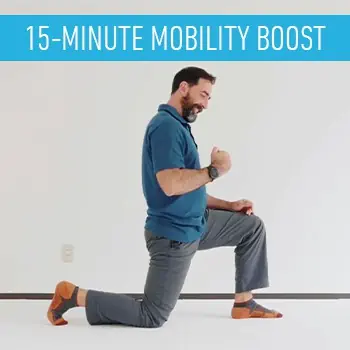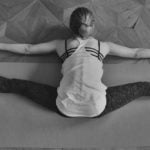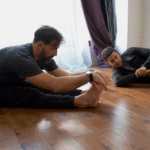Most people wish they were more flexible, but most flexibility training feels like a weird form of torture.
 You fold yourself into painful positions and sit there for 10 times as long as you want to.
You fold yourself into painful positions and sit there for 10 times as long as you want to.
Do that every day for a few months until you are absolutely positive it didn’t work, and then you can go back to being tight, sore, and restricted, just like always.
If you’ve experienced something like that, you’re not alone.
I’ve been a physical therapist and martial artist for decades. And in my experience most people want to be more flexible but hate training for it.
Because most flexibility training is just… bad.
It consists of cookie cutter routines and promises that if you just reach hard enough, you’ll somehow eventually touch your toes.
But the actual “trick” to fast flexibility is to focus on the areas you personally need to work on, and then to train with the most efficient tools. This requires a bit of self-reflection and critical thinking, but you’ll make much faster and more valuable progress than just following someone else’s stretching routine.
In this article, I’ll show you the four simple steps I recommend to rapidly improve your flexibility without having to stretch for hours every day.

Loosen All Your Major Joints
Get the quick routine that’s helped thousands of people move better with less pain, yours free.
Why Do You Want to Get Flexible?
 It seems that as people begin and continue with their exercise and fitness regimens, they always feel as if they should work on their flexibility, even if they already have a dedicated practice in place.
It seems that as people begin and continue with their exercise and fitness regimens, they always feel as if they should work on their flexibility, even if they already have a dedicated practice in place.
Why is that? Is it because everybody says you should?
If so, that’s not a very good reason. Maybe you don’t have to spend so much time on your flexibility after all.
If you are getting through your day and your recreational activities without sensations of stiffness or tightness in your muscles, then you probably don’t need to make flexibility training your top priority.
If however, you do feel stiffness or tightness and can’t seem to put your shoes on in the morning without some serious effort, then some flexibility training may be exactly what you need.
Below, I’ll show you how to improve your flexibility quickly (and safely). It just requires having focus, motivation, and ironically, a lot of patience.
4 Steps to Get Flexible Fast
 In our hectic lifestyles, going from home responsibilities to work responsibilities and back again, we barely have time to get a regular workout routine in.
In our hectic lifestyles, going from home responsibilities to work responsibilities and back again, we barely have time to get a regular workout routine in.
It’s hard enough to find even 45 minutes for the whole training session, let alone another 20 minutes or so to stretch out where we need to. Instead of wasting time with inefficient, cookie-cutter stretching routines, follow these steps:
1. Figure Out Your Flexibility Needs
 First of all, let’s clarify why you want to stretch and work on your flexibility. There are a lot of reasons floating around out there as to why you should stretch.
First of all, let’s clarify why you want to stretch and work on your flexibility. There are a lot of reasons floating around out there as to why you should stretch.
- Decrease muscle soreness after a workout
- Decrease risk of injury
- Improve performance
- Improve range of motion
- Reduce pain
Actually, it may be surprising you to learn that the benefits of stretching are controversial and far from conclusive. In fact there is a fair amount of evidence that stretching isn’t as helpful as you’d think for decreasing pain and chance of injury.
In this article the author eventually comes to the conclusion that stretching is only good for improving flexibility… and it “feels pleasant.”
Well, frankly those are the only reasons to stretch!
Our stance on flexibility work is that “if you cannot actively attain a position you’d like, then you need to find a way to get to that range of motion.”
Yes, it really is that simple.
So how do you know if you need to stretch?
- If you have poor form in a handstand because your arms don’t fully raise above your head, then you need to stretch.
- If you want to play with your kids but you have trouble getting down on the floor because you’re too tight, then you need to stretch.
As we’ve said before, you have to find your right motivation.
Many people may tell you “that you MUST stretch” for a variety of reasons, but don’t worry about it. Instead, focus on the motivating factor for you.
Find your own personal reason, as that will get you to your objective much quicker and take you much further than some other contrived justification.
2. Determine What’s Holding You Back
 Once you have that goal in mind, you’ll next want to find out what in particular is hindering you from achieving it.
Once you have that goal in mind, you’ll next want to find out what in particular is hindering you from achieving it.
And it’s much more than “I have to stretch out more.”
Sure you do, but do you know which muscles you need to stretch? All of them? Well, that would take a pretty long time!
It may be that you have a difficult time bending forward to touch your toes, and that would naturally make you think that your hamstrings are too tight but there are quite a few other things that could be restrictors as well, such as your low back, hip flexors, glutes, etc.
So you’ll need a good way to quickly assess what is specifically binding up your movement.
The best way I’ve found to do that is to go through a targeted series of positions that tests your whole body, and to note where you feel most restricted.
We call these Basic Assessment Positions.
I developed this series of Basic Assessment Positions (BAPs) as a quick and efficient way for people to self-assess their entire body and perhaps even discover areas they didn’t know were so restricted.
- Squat
- Crosslegged Sitting
- Longsitting
- Supine Hip/Knee Flexion
- Hooklying Crossleg Hip Rotation
- Shoulder Combined Motions
- Prone Backbending
- Neck Motions
By starting with the most noticeable restrictions, you’ll probably notice other parts of your body moving more freely as well. It’s like untangling a rope—once you find the primary knot, the rest unravels pretty easily.
So the stretching you do will make the best use of your time, since you’ll be working on the most important stretches for your needs.
3. Get Flexible Faster By Slowing Down
 The difficulty in trying to get flexible as quickly as possible is that most people need to tone it down.
The difficulty in trying to get flexible as quickly as possible is that most people need to tone it down.
You don’t improve stretching tolerance by going so far with a stretch that it hurts. In fact, that would likely impede your progress. It is both a reflexive and conscious action to draw back from a painful stimulus.
The inability to move in a certain range of motion because of “tightness” can be related to several factors:
- Soft tissue scarring (actual structural adhesions preventing motion)
- Joint hypomobility (restrictions at the joint itself due to injury or congenital factors)
- Higher resting muscle tone (the muscle’s resistance to stretch at rest)
The first two factors are best addressed by consulting a professional in person, but the last leads to the reason why most people need to go a bit more slowly in their stretching regimen.
Muscle Tone, Not Intensity Determines Your Flexibility Gains
Though there are some medical conditions that can cause a very high muscle tone, most of us just have varying degrees of the level, and this explains why some people are naturally more or less flexible than others.
It’s only natural to go for intensity when you are exercising and are focused on a goal.
This is great for pushing through fatigue to build stamina and endurance but for improving flexibility, fighting this natural tone is a losing battle.
Instead, you are better off coaxing your body into improved flexibility.
Easing into it rather than going “hardcore” is going to get you better results. Here’s why:
Across the board, clients that have listened to this advice are achieving much better success.
I took my time and really focused on Jarlo’s advice about not pushing. Toward the end I began to feel how my muscles would resist straight pushing but relax into softer rhythmic pushing cycles letting me get deeper. A very nice session.
– Kevin K.
There are periods of time where really pushing yourself harder into the stretched position is useful, but these are at more advanced levels of flexibility training.
And by no means will it be the majority of your training, they are done a small percentage of the time to make a small percentage of gains. If you feel so tight that you have trouble touching your toes, you definitely don’t need to be doing this style.
4. Follow Your Plan As Consistently As Possible
 You’ve now figured out your personal goal, identified your restrictions, and improved your approach to stretching by toning it down. The last, but not least, thing to do is to follow a consistent plan of attack and do it as regularly as you can.
You’ve now figured out your personal goal, identified your restrictions, and improved your approach to stretching by toning it down. The last, but not least, thing to do is to follow a consistent plan of attack and do it as regularly as you can.
Your plan has been formed from your personal goals and mobility restrictions.
The gains from this plan build up from session to session and that’s a matter of consistent practice and giving your body a chance to adapt to those gains.
Getting Specific with Your Stretching Routine
The answers to what you need to do to improve your flexibility lie within you and your current condition and specific needs.
In my decades as a physical therapist and martial artist, the four strategies I outline above are the best I’ve learned for quickly improving flexibility in any part of the body. Here’s a handy chart to help you remember them:
| How to Get Flexible Fast |
|---|
| 1. Determine your real flexibility needs |
| 2. Figure out where you're most stiff |
| 3. Be patient and consistent with your flexibility work |
| 4. Stick to a stretching plan (don't try to wing it) |
Retaining Your Flexibility Once You Have It
 If you’ve tried stretching in the past, you’ve probably had the experience of getting to the end of a session and feeling like you were making progress, only to have that progress disappear by the time your next session rolls around. It doesn’t do you any good to make a change only to lose ground again.
If you’ve tried stretching in the past, you’ve probably had the experience of getting to the end of a session and feeling like you were making progress, only to have that progress disappear by the time your next session rolls around. It doesn’t do you any good to make a change only to lose ground again.
This may happen to people because of the body’s natural tendency to revert to what it perceives as the normal condition. Our bodies are actually averse to big changes in short periods of time.
Homeostasis and the set point theory indicate that our bodies like the status quo.
And big swings away from your current condition can set off alarm bells. It’s one of the reasons behind yo-yo weight changes where people lose or gain a bunch of weight only to revert back to their previous condition again.
A great way to prevent this from happening is to use your new ranges of motion.
If you consistently move your body through a certain range of motion, your body will reinforce and protect it. It becomes the “new normal.”
This is more than just going in and out of that stretched position, though.
In fact, the best way to do this feels less like stretching and more like playtime. Explore your new ranges of motion from different angles. Get into them in different ways. Come out of them in different ways. Incorporate them into your hobbies or even chores.
This is why our clients get such great flexibility gains from our Elements program, even though it’s not focused exclusively on improved range of motion. The programs movements erode tight spots the same way waves reshape a cliff face.
By putting you new ranges of motion into… well… motion, you show your body that they are valuable, and you lock in your improvements in flexibility.
Save Time With an Efficient Stretching Method
Everyone knows how to stretch. But chances are you were never taught how to stretch efficiently.
 The truth is, most people who try stretching are using methods that don’t get very good results for the effort they put in.
The truth is, most people who try stretching are using methods that don’t get very good results for the effort they put in.
Which means they end up wasting a lot of time. And it really doesn’t need to be this way.
We created our Mobility program to help you efficiently improve your range of motion in all your major joints. It works right alongside your current training so you can move and perform your best. Check it out 👇
Build Flexibility That Actually Helps You Move
GMB Mobility is a guided program that improves your total body mobility. You’ll resolve restrictions so you can finally move and perform your best.






